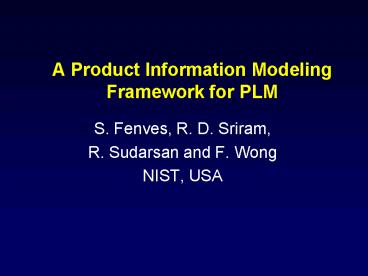A Product Information Modeling Framework for PLM - PowerPoint PPT Presentation
1 / 26
Title:
A Product Information Modeling Framework for PLM
Description:
... Gear Example. Bearing. Output. Housing. Washer. Input Shaft. Planet Gear Pin ... Framework is a first step towards a complete product modeling architecture ... – PowerPoint PPT presentation
Number of Views:55
Avg rating:3.0/5.0
Title: A Product Information Modeling Framework for PLM
1
A Product Information Modeling Framework for PLM
- S. Fenves, R. D. Sriram,
- R. Sudarsan and F. Wong
- NIST, USA
2
Outline
- Product Engineering Program
- Integration Framework
- Core Product Model
- Design-Analysis Integration Model
- Open Assembly Model
- Product Family Evolution Model
- Summary
3
Product Engineering Program in Design Process
Group
- Objective
- establish a semantically-based standard product
representation scheme supporting seamless
interoperability among CAD systems and others - Anticipated environment
- Initially from design to analysis to
manufacturing (design-in-the-small, PDM) - Currently from conceptualization to disposal
(design-in-the-large, PLM)
4
Context external
- PLM is a strategic business approach for the
effective management and use of corporate
intellectual capital Various Sources
Discover
Prototype
Design
Manufacture
Market
Maintain
CADPDMDMU
PLM
5
Context internal
Manufacturing System Integration Division roadmap
Self-integrating systems
Self-describing systems
Explicit, formal semantics
Common models of data
We are still laboring on first 1 ½ steps
6
Progression of activities
7
Interoperability Framework for PLM
- Objectives
- serve as generic depository of all product
information at all stages - deliver all product description information to
PLM and subsidiary systems using a single,
uniform information exchange protocol - support direct interoperability among CAD, CAE,
CAM and other interrelated systems
8
Interoperability Framework
- Attributes
- based on formal semantics (later ontology)
- generic deals with concept of artifacts
- specific instances can be generated (e. g.,
motors, pumps or gears) - repository of variety of information about
products - intended to foster novel applications and
processes - incorporates explicit representation of design
rationale - convertible into production-level framework
9
Framework Components
10
Core Product Model
- Objective base-level product model that is
- generic
- extensible
- independent of any one product development
process - capable of capturing full engineering context
- Key feature explicit representation of
- Function Form - Behavior
- (in contrast to STEP AP 209 that essentially
represents only form )
11
Knowledge Representation
A product is represented by a hierarchy of
entities of the class Artifact, which is an
aggregation of Function, Form and Behavior.
Function represents what the artifact is supposed
to do Form represents the proposed design
solution for the design problem specified by the
Function and Behavior represents the evaluation
of how the artifact implements its function.
12
Core Product Model Objects
13
Core Product Model Relationships
14
Design-analysis Integration Model
- Objectives
- support tighter design-analysis integration than
is possible today - support broad range of discipline-specific
functional analyses - make analysis-driven design (form-to-function
reasoning) more practical - eventually support opportunistic analysis
- Key feature two models and two one-way
associations
15
Design-analysis Integration Model
16
Design-Analysis Integration Model
- Organizing principles considered
- net shape, as in AP 209 (eliminates
function-based reasoning) - design/analysis features (not mature)
- the Core Model
- Potential implementation mechanism
- Master Model is virtual
- a metamodel defines executable idealization and
mapping transformations
17
Open Assembly Model
- Objectives
- provide a standard representation and exchange
protocol for assembly and system-level tolerance
information - be extensible
- Key features
- emphasizes the nature and information
requirements for part features and assembly
relationships - includes both assembly as a concept and assembly
as a data structure
18
Open Assembly Model
19
Open Assembly Model Tolerance
20
Planetary Gear Example
21
Assembly Hierarchy
22
Assembly Associations
fc fixed connection mc movable connection
po position and orientation
23
Product Family Evolution Model
- Objectives
- represent the evolution of product families and
of the rationale for the changes - Key features
- keeps track of product component series
versions configuration relationship ties them
together - keeps track of what, how and why of all changes
between versions/series
24
Product Family Evolution Model Family
25
Product Family Evolution Model Evolution
26
Product Family Evolution Model Rationale
27
Summary
- Framework is a first step towards a complete
product modeling architecture supporting the full
PLM philosophy - Research needed
- identify other framework components needed
- clarify product information needs of PLM process
- consider interactions between product data
provided by framework and metadata maintained by
PLM system - Identify information exchange standards that can
provide needed degree of interoperability































